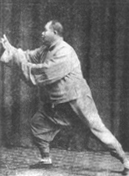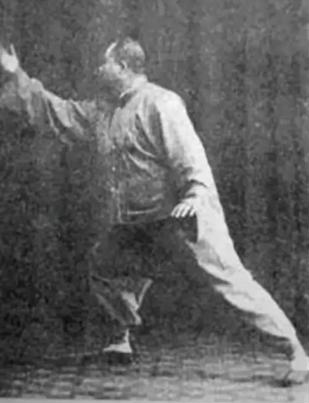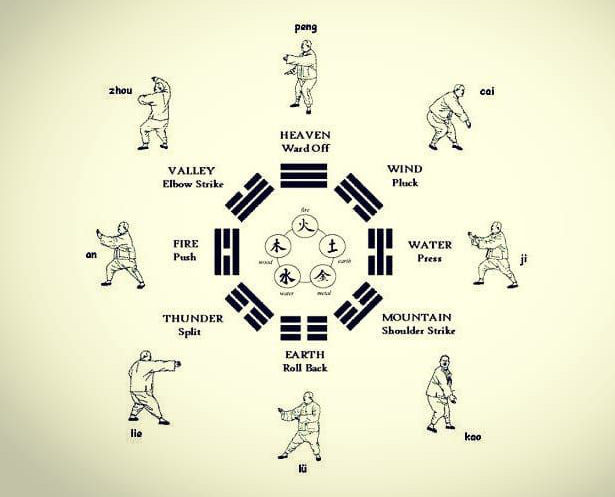According to the theory of Tài Jí Quán 太極拳, this martial arts system uses eight types of energy or strength (jìn 勁). This word refers to an energy cultivated by the practitioner in a specialized manner, that is, it is the result of a prolonged training, as well as the combination between physical energy, 力 lì, and internal energy, 氣 qì.
To say that Tài Jí Quán uses eight energies, is to say that the energy used by the movements and techniques of the system can be classified, more or less crudely, into eight categories.
These eight energies are also sometimes called Eight Gates (八門 bā mén), and are divided into four primaries and four secondary ones.
Primary energies:
1. Péng 掤 (ward off):
Péng is a type of energy that expands outwards, destabilizing the opponent. It is somehow similar to the energy of a spring, which when pressed and contracted, accumulates energy that is released as it expands again. This energy is born from a good rooting of the feet on the ground.

Master Yáng Chéngfǔ 杨澄甫 demonstrating péng 掤.
2. Lǚ 捋 (rub, roll back):
Lǚ is a type of yīn 陰 energy that is based on the redirection of an external energy that comes (usually àn 按), creating a vacuum to, again, causing the opponent to lose balance. This redirection results in adhering to the opponent. Lǚ is a soft energy, it yields, it's receptive. This means that it does not object, that it does not resist the movement of the adversary, but yields to the adversary, accompanying him.

Lǚ 捋.
3. Jǐ 擠 (press, squeeze):
Jǐ can be translated as squeezing, pressing or compressing. It refers to putting pressure on a specific point.
4. Àn 按 (push):
Àn is pushing energy. Normally both hands are used, but the thrust does not come from the arms but from the entire structure of the body. It can be horizontal, or slightly up or down.

Àn 按.
Secondary energies:
5. Cǎi 採 (pluck):
Cǎi is basically like lǚ but downwards. It redirects the attacking energy to the ground, adhering to the opponent.
6. Liè 挒 (split):
Liè involves the use of two forces in opposite directions, to separate two parts of the opponent's body. These two opposing forces are not necessarily to be applied only with the hands, but can be applied with hands and feet simultaneously, as we see in the movement "Flying diagonally" (斜飞式 xié fēi shì).

Liè 挒.
7. Zhǒu 肘 (elbow, elbow strike):
Zhǒu is a short-range energy applied in an elbow strike. The energy is born from the feet and is "governed by the waist". It can also be applied as a block or as a control to the opponent, and can have different directions.
8. Kào 靠 (lean):
Kào is an energy expressed in the trunk. It often translates as "shoulder strike", but it doesn't necessarily have to manifest itself exactly this way. Literally, it means leaning on something or bending over. In this inclination, the shoulder usually goes first; hence that translation of "shoulder strike." In fact, kào can be a shoulder blow, both with the front and with the back, but it can also be with the chest or back.
The Treatise of Tài Jí Quán (太極拳論 Tài Jí Quán Lùn) assimilates these energies to the Eight Trigrams or Eight States of Change (八卦 bā guà), and to the eight cardinal directions.
The eight energies are followed or transformed into one another. For example, lǚ (roll back) usually transforms into jǐ (press), such as in "grabbing the sparrow's tail" movement (揽雀尾 lǎn què wěi), or cǎi (pluck) into liè (split). This cycle of transformation is the same that governs the transformation of yīn 陰 into yáng 陽 and yáng into yīn, that is, the transformation of the soft to hard and the hard into soft.

The transformation of the soft into the hard and the hard into the soft
We have already talked about how certain energies "yield" to the movement of the adversary. This is based on the Taoist philosophy of non-resistance. Resisting involves a struggle and a considerable expense of energy, and does not always ensure the desired result. If the enemy is physically stronger, resisting won't do any good. In this case, yielding and using the opponent's energy in our favour becomes the best option.
Looking at it from another angle: when we try to move a very large weight that is at rest, it is necessary a great physical strength, with the consequent energy expenditure, to achieve it. However, if this weight, however large, is in motion, we will notice that it is much easier to move, and it will not be necessary to use a lot of energy. This is called "Four ounces move 1000 pounds" (四兩撥千斤sì liǎng bō qiān jīn). This saying simply means that something very light can move something very heavy.
All this is based on the non-opposition of resistance, that is, to yield; it's soft energy. With the application of soft energy we manage to destabilize the opponent, and when this destabilization occurs, the soft energy becomes hard, manifesting itself in a blow. While we yield, we absorb or accumulate energy (蓄勁 xù jìn); by hitting, we release energy. This release of hard energy lacks subtlety, and is more easily noticeable than soft energy; it is referred to in Chinese as fā lì 發力 or fā jìn 發勁, and is generated by the coordinated movement of the whole body. Fā jìn refers to the externalization of energy. It is said that qì "is rooted in the feet, is released through the legs, ruled by the waist and expressed in the fingers".
In Tài Jí Quán, the soft and the hard alternate, yīn and yáng generate each other. Through practice and experience, one comes to "understand the energy" (懂勁 dǒng jìn). Understanding the energy means understanding the interaction between yīn and yáng. According to the Treatise of Tài Jí Quán, this understanding brings us closer to spiritual enlightenment (神明 shén míng).

2 thoughts on “The Eight Energies of Tai Ji Quan”
Very useful indeed. Thank you. Many if not most Taijiquan websites do not bother with the hanzi but this is vital for in-depth understanding. My only constructive criticism is you did not include images for energies 5 to 8.
Thank you Simon for your appreciation. We will try to get those images, as you suggested.
Best regards,
Juan